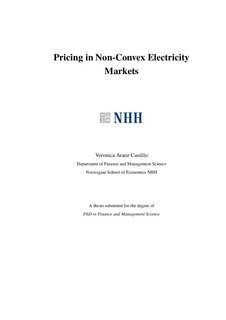Pricing in Non-Convex electricity markets
Doctoral thesis
Permanent lenke
http://hdl.handle.net/11250/226579Utgivelsesdato
2012-05Metadata
Vis full innførselSamlinger
Sammendrag
Deregulation of the electricity markets has brought several interesting topics to the
research agenda. Switching from a monopoly based industry to the free market industry
has not been straight forward. The competitive segments of the deregulated
electricity markets, the wholesale market and the retail market, have evolved in
different ways across the globe, and consequently there are different market designs
and different pricing mechanisms.
If we assume that a neoclassical economic model applies to the electricity market,
then the monotonically increasing supply curves of all generators would be aggregated
to create the industry supply curve. Similarly, the monotonically decreasing
demand curves of all consumers would be aggregated to create the industry demand
curve. The competitive equilibrium price for electricity would be set at the
level where the two curves intersect.
It is important to highlight that convexity is a property that economic models require
for a competitive equilibrium. However electricity treated as a commodity
has several characteristics that do not fit into the neoclassical economic model.
First of all, electricity cannot be stored; therefore the total production should always
match total consumption. In addition, electricity generators have several
operational requirements to avoid problems with the technology used, such as
minimum and/or maximum output, start-up and shut down costs, and minimum
ramp rates. These requirements generate non-convexities in the production function.
Moreover, generators are committed to production in indivisible units, which
also creates non-convexities. On the demand side, it has been seen that the demand
function is extremely inelastic, which may contribute to high spikes in prices.
